She said:
I thought about flowers in context of Christmas. The most popular plants are Holly, Ivy, Mistletoe and 'Christmas tree'.
But there is something else, a very nice flower: Christmas rose (Helleborus niger, Ranunculaceae). My mother brought it to my mind when she asked me for a painting of it. It is flowering in winter, from december to march, looking like a little star.
An old tale says a young shepherd was going to visit the newly born Jesus in the stable. He was very sad because he didn't have a present or even flowers for Jesus, and he started to cry. His tears fell down on earth and suddenly beautiful flowers sprouted out of it: Christmas-Roses.
Another (newer) tale is about an owl bringing a stalk with an ice crystal to Jesus. In the moment the owl put the ice crystal into the crib it turned into a flower - a christmas rose.
Helleborus niger has a long tradition as herb; all parts of it are poisonous. It is used (usually in homeopathy) as treatment of deseases of heart and blood circulation.

Denise's Christmas Rose
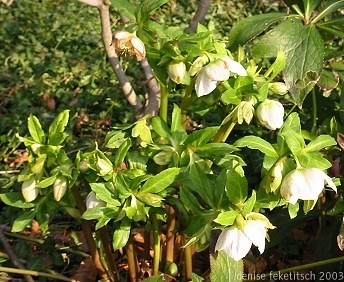
Shepherd's tears on earth
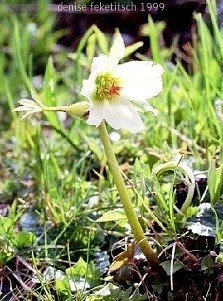
A stalk with ice crystal from owl
The Christmas rose is related to anemones, like the one you know from my homepage: Anemone sylvestris.
It also got a very nice English name: 'Snowdrop anemone'
[anemone 银莲花]
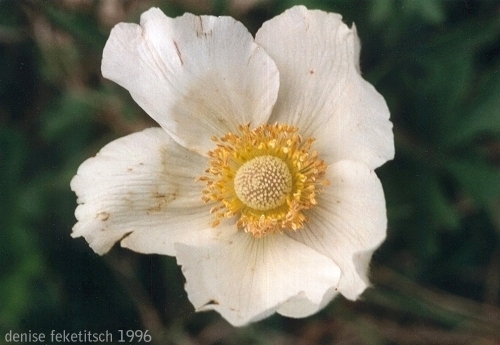
Denise's Anemone sylvestris
The flower seems familiar to me, although I know I never see it before.
What is it? I go back to the sunny summer afternoon at Rot. Flowers are blossoming, wasps are buzzing.
That afternoon the shuttle bus didn't come. We rushed out from Ralf's workshop: quick quick, we'll be late. Then waited at building gate. Time passed, we checked watch, well, we were on time. Then we began to suspect, did we understand the bus driver right in the morning? He said we should wait here, right?
Every day we praticed 3 words in German. Ah, that's good, helps everywhere. In the morning, say 'Morgan', then get on bus, say 'Danke'. Then arrive, say 'Danke' again, get off, say 'Tschuess!'. :) Of course in the afternoon, it is: Hallo! Danke! Danke! Tschuess!
The driver changes everyday, they are all very kind. Every morning when we arrived office building, they would tell us where to pick us up in the afternoon, in German and gesture.
So we three discussed and each got a task. George went back to office and called hotel about the shuttle. Kat waited there and began her gigarette break. I, went over the lane with flowers to the meeting point, see whether he was waiting us there.
So bright shining sun, I was happy with my camera to check over there.
The bus was not there, I shook back to Kat. And Kat shook back that bus didn't come yet. That's good, I took my time back. A very long walk.
Kat said, ah, you really walked very slow! Yes, stopped here and there. Every flower was blossoming.
George was still in office to make himself understood by the hotel girls. Kat had finished the cigarette. We had nothing to do. So, we both took out camera and focused on the buzzing wasps. :)
I got a lot of nice pictures.
A little later, hotel said the bus was coming. It turned out to be a handsome young lad with a very cool car! We all got in very happily.
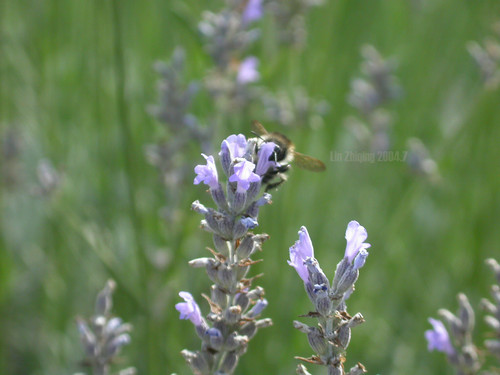
A wasp busy in lavendar

Lavendar blossoming
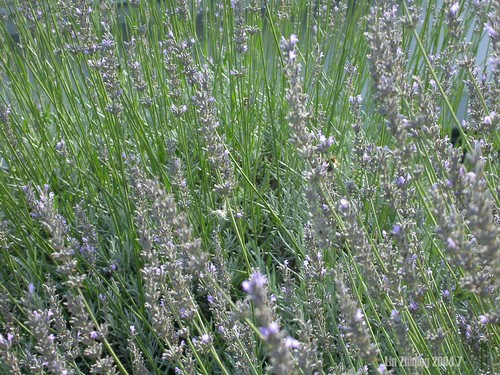
Lavendar bush, a lot of wasps buzzing in it
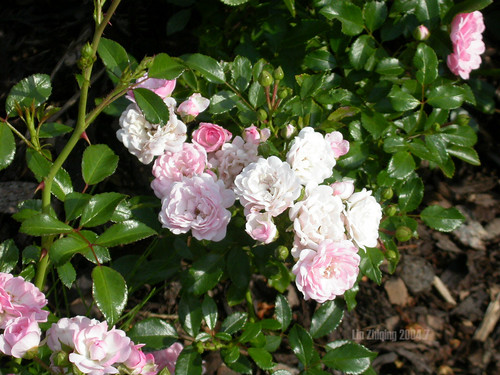
Roses
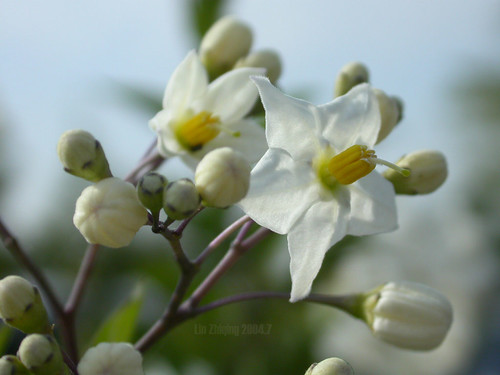
This flower is very beautifull, shivering in the wind. It's hard to focus on it. But once succeed, it is so nice.
Denise said:
This is from the family of nightshades (Solanaceae), very similar to potato, tomato etc. I guess it is black nightshade (Solanum nigrum) which is quite common around here. I like this plant because of its beautiful flowers and its nice name. It is very poisonous and used as a drug / herb.
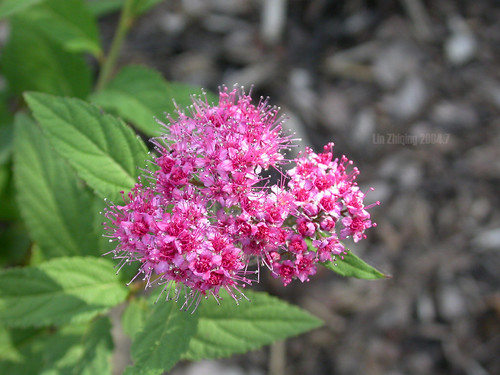
I don't know what it is.
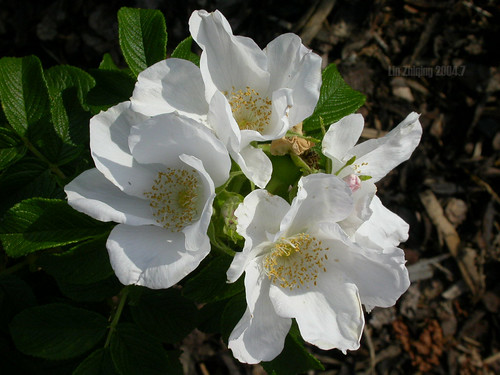
This is the one I feels like the Christmas Rose, only the flower.
Denise said:
Rosa rugosa, common names: rugose rose, potato rose, tomato rose, Chinese rose, Japanese rose... It comes from NO Asia. It is planted widely in Europe, at streets, on coast. I first met them in denmark, where lots of them grow in the sand dunes. Later they became common in our region, too. The fruits (rose hips) taste nice, but you have to be carefull not to eat the small hairs inside between the seeds, they cause itch.
The fruits - like other rose hips - are used as herbal tea.
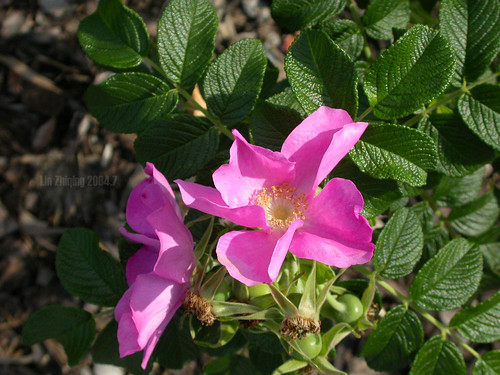
A pink version
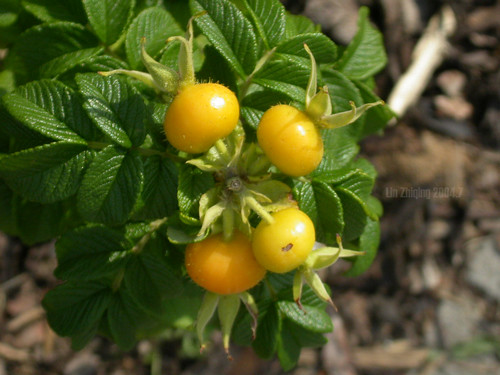
The small fruits with hairs.
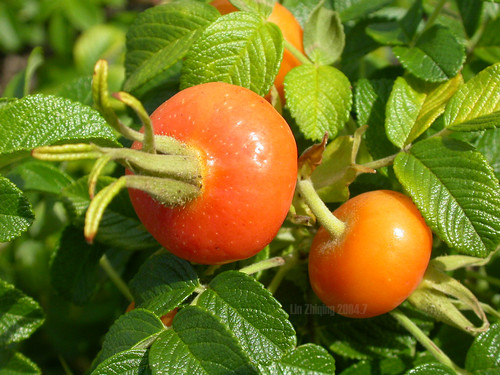
Bigger fruits.
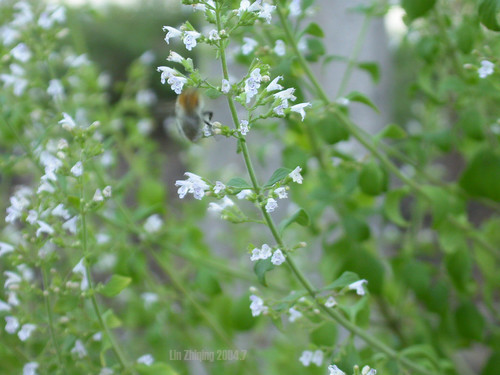
Another busy wasp

calmer wasp

A Friday afternoon at Rot. Duty off, weekend ahead.
Photos stored at:Christmas Rose and Flowers in Rot
-----------------------
Ah, recalling beebuzzing summerdays... your photos make this grey, cold and wet winterday brighter.
The pink flower between nightshade and rugose rose is a spirea, probably Spirea japonica. In English it is called 'meadowsweet' because of its sweet fragrance.
It belongs to the family of roses (Rosaceae).
Denise
评论人:dropin 评论日期:2004-12-19 22:15
Funny, the rugose rose comes from No asia, but it has the name of Chinese rose, Japnese rose. How it comes?
The rugose rose seems quite like the local wild rose here, 野蔷薇。which is scented ardently in late spring of May while warm bathing in bright sunshine.
The shepherd tear reminds me of peony, 牡丹,芍药, it seems to me their petals and pistills are so alike....so..the shepherd tear also has a Chinese name of autumn peony. But the leaves different.
Nightshade -- yes, the potato and tomato have the same flowers, white five petals wtih the sharp tips. Eggplant too, but its flowers are purple
评论人:linz 评论日期:2004-12-20 10:21
I didn't know spirea has frangrance... I should smell hard
I only see there are a lot of such flowers. It goes brown after the pink over.
牡丹不是:
五桠果亚纲,芍药科:

学名:Pagonia suffruticosa Andr.
英文名:Subshrubby Peony
科名:芍药科 Paeoniaceae
looks similar though...
Shepherd tears is 木兰亚纲 毛茛科 Ranunculaceae
get another

Anemone cathayensis
Ah, get this one:
Ranunculaceae:
白头翁
学名:Pulsatilla chinensis (Bunge)Regel
英文名:China Pulsatilla
科名:毛茛科 Ranunculaceae
有的地方说白头翁就是秋海棠
但秋海棠是这个:
四季秋海棠
(Begonia semperflorens)
毛茛
学名:Ranunculus japonicus Thunb.
英文名:Japan Buttercup
科名:毛茛科 Ranunculaceae
O, this makes me think of this one, five petals, too.
the flower on earth this spring in Hang Zhou
野生牡丹是的

野生牡丹
但是芍药是毛茛科。。。 奇怪。。。

芍药
Paeonia lactiflora
Paeonia is Ranunculaceae, not Paeoniaceae... hard to understand...
评论人:乱看 评论日期:2004-12-20 12:26
OK, I will sort the chaos.
@ linz: sorry,my fault - I wanted to say: Rosa rugosa comes from North-East Asia. The German word for 'East' is 'Ost', 'NO' is short for 'Nord-Ost'. Yes, it is the wild rose you know.
Taxonomy (or systematics: classification of plants and animals) is neither natural nor definite. People just try to bring an artificial system into the 'chaos' of nature. The more they know about the habit, the biochemistry, the genetics the better they can find relationships.
Paeonia once was thought to belong to the family of Ranunculaceae. But there are too many differences:
- a ring (discus) between androeceum and gynoeceum (male and female parts of the flower)
- different number, size or structure of chromosomes
- different structure of proteins
etc.
So they found out that Paeonia forms an own group that is closer related with plants like passionfruit or papaya. Funny, isn't it?
The white flower from Hang Zhou looks like Rosaceae, probably Rubus (like Rubus fruticosus, Blackberry).
Maybe it helps if I give you a short summary of the current systematics of plants:
If we only regard the flowering plants with fruits (no ferns, no coniphers), there are 2 Classes (-atae): Magnoliatae and Liliatae.
- Magnoliatae are plants with 2 cotyledons (= the first leaves of the sprout) 双子叶植物纲(木兰纲)
- Liliatae (diao lan, orchids, lilies, asparagus etc.) only have 1 cotyledon. 单子叶植物纲(或百合纲)
Magnoliatae are divided into 8 subclasses (-iidae).
Each subclass contains several orders (-ales) which contain several families (-aceae).
1. Magnoliidae 木兰亚纲
e.g. anemone 银莲花 (Ranunculales , Ranunculaceae 毛茛科),
lotus (Nymphaeales, Nelumbonaceae 莲科),
(black, white, green) pepper (Piperales, Piperaceae 胡椒科)
2. Caryophyllidae 石竹亚纲
e.g. campions 剪秋罗(Caryophyllales, Caryophyllaceae 石竹科)
3. Hamamelididae 金缕梅亚纲
e.g. beech 山毛榉, oak (Fagales, Fagaceae 壳斗科),
birch tree 白桦 (Fagales, Betulaceae 桦木科 )
walnut 胡桃(Juglandales, Juglandaceae 胡桃科)
4. Rosidae 蔷薇亚纲
e.g. roses, apple, cherry, peach, plum (Rosales, Rosaceae 蔷薇科)
beans 豆, peas 豌豆 (Fabales, Fabaceae 蝶形花科)
5. Asteridae 菊亚纲
e.g. bellflowers 吊钟花(Campanulales, Campanulaceae 桔梗科)
sunflowers (Asterales, Asteraceae 菊科)
6. Dilleniidae 五桠果亚纲
e.g. paeonia 芍药(Dilleniales, Paeoniaceae 芍药科)
pumpkin (Cucurbitales, Cucurbitaceae 葫芦科)
tea (Theales, Theaceae 山茶科)
cotton (Malvales, Malvaceae 锦葵科)
cocoa (Malvales, Sterculiaceae 梧桐科)
cabbage (Capparales, Brassicaceae 十字花科)
7. Cornidae 山茱萸亚纲
e.g. coffee (Gentianales, Rubiaceae 茜草科)
olive trees (Oleales, Oleaceae 木犀科)
8. Lamiidae 唇形亚纲
e.g. mint, motherwort (Lamiales, Lamiaceae 唇形科),
nightshade (Solanales, Solanaceae 茄科)
I hope I haven't caused too much of new confusion...
Denise
评论人:dropin 评论日期:2004-12-20 17:45
Oh, I wanted to say: I will *try* to sort the chaos. No idea if I managed it...
评论人:dropin 评论日期:2004-12-20 17:48
This is really what i/we want to know, the basic knowledge on taxonomy. No chaos, i will go along with it bit by bit and make it clear step by step, as Chinese saying...Good good study, Day day up...
One difficulty is, not so easy to translate those profound scientific English words into professional Chinese. I believe LK will help me.
Magnoliatae, 木兰科? 双子叶
Liliatae, 百合科? 单子叶
Well, need more time to digest it @@@@!" , thank you Denise
评论人:linz 评论日期:2004-12-21 17:18
I'm happy if I could help you, linz! :))
Just ask me when you want to know more about it. Plant taxonomy is one of my favourite topics.
Denise
评论人:dropin 评论日期:2004-12-21 18:50
Chinese Taxonomy
Here, a Chinese on Plant Taxonomy.
植物界(Regnum vegetabile)
门Division
纲Class -atae
亚纲Subclass -iidae
目Order -ales
科Family -aceae
属Genus
种Species
评论人:linz 评论日期:2004-12-22 14:32
please always keep in mind, that this taxonomy is just a model, where biologists try to name relations they find in reality.
as research goes further, taxonomy is subject to be changed ...
but since you know the way science works, you will find this normal (i suppose).
sebastel
评论人:dropin 评论日期:2004-12-22 22:00
I've add on some Chinese mapping
Em, here's a good site of Nanjing University, plants arround this area:
Plants on Zi Jin Mountain, Nanjing 紫金山植物
They use 6 subclasses
评论人:乱看 评论日期:2004-12-22 23:13
i'm glad that recently i increased my allowed bandwidth.... hope it becomes active soon.
sebastel
评论人:dropin 评论日期:2004-12-23 0:45
err... not bandwidth but "monthly transferred data" ..
评论人:dropin 评论日期:2004-12-23 0:46
wow~ this is a great task u translated those names into Chinese, where did u get the dic?
I have a book on herb & spice plant, it lists those herbs and spices we can use, internationally approval. I give u some abstract here.
Labiatae 唇形科
Hyssop, Marjoram, Peppermint, Sweet Basil, Rosemary, Sage, Thyme...
Umbelliferae 伞形科
Dill, Angelica, Celery, Coriander, Parsley, Anise, Fennel...
Zingiberaceae 姜科
Cardamom, Galanga, Turmeric, Ginger...
Lauraceae 樟科
Cassia, Cinnamon, Bay
Cruciferae 十字花科
Horseradish, Mustard
Myrtaceae 桃金娘科
Clove, Allspice(Pimento), West Indian Bay
Liliaceae 百合科
Shallot, Onion, Welsh Onion, Garlic, Chive
( For shallot, onion, and garlic, we use their bulbs; but welsh onion and chive we use leaves, so i think the one with green hollow leaves we use in chinese dishes is chive. I don't know what welsh onion is.)
Solanaceae 茄科
Capsicum (
评论人:linz 评论日期:2004-12-23 14:27
Solanaceae 茄科
Capsicum (Chilli)
Rutaceae 芸香科
Curry Leaf Tree
Piperaceae 胡椒科
Pepper
Orchidaceae 兰科
Vanilla
Leguminosae 豆科
Tamarind, Fenugreek
Anacardiaceae 漆树科
Mango
Punicaceae 石榴科
Anardana
Capparidaceae 白花菜科
Caper
Ranunclulaceae 毛莨科
Garden Fennel Flower
Cupressaceae 柏科
Juniper
Myristicaceae 肉豆蔻科
Myristica
Papaveraceae 罂粟科
Poppy
Iridaceae 鸢尾科
Saffron
Magnoliaceae 木兰科
Star Anise
Araceae 天南星科
Calamus
Compositae 菊科
Tarragon
Annonaceae 番荔枝科
Xylopia
Names sound charming ;)
评论人:linz 评论日期:2004-12-23 14:39
太好了,修竹贴了这个:粉花绣线菊
正是那个粉红的花
Hey, see this, according to Mr. Bamboo, the spiraea is Spiraea japonica
Seems exactly the same.
修竹的粉花绣线菊 Spiraea japonica
评论人:乱看 评论日期:2005-1-2 13:37
Nice coincident :))
Yes, I also guessed it could be Spiraea japonica
In Germany you can find many different Spirea species (at least 25) and hybrids (at least 26), most of them coming from East Asia.
My books describe several breeds of Spiraea japonica (naturally with pale pink flowers): 'Atrosanguinea', 'Bullata' and 'Bumalda' with dark pink flowers, 'Albiflora' with white flowers, 'Nana'with pale lilac flowers.
Some more words on taxononmy! ;)
The family Rosaceae is a interesting group of plants. It is divided into 4 Subfamilies:
1. Spiraeoideae
- the spirea-like: e.g. Spirea spec., (Exochorda spec., Sorbaria spec. Stephanandra spec.: East Asien shrubs, sometimes planted in German gardens)
2. Rosoideae
- the rose-like: e.g. Rose (Rosa spec.), Blackberry and Raspberry (Rubus spec.), Strawberry etc.
2. Maloideae
- the apple-like: e.g. Apple (Malus spec.), Pear (Pyrus spec.), Quince (Cydonia oblonga), Whitethorn (Crataegus spec.) etc.
3. Prunoideae:
- the plum-like: e.g. Plum (Prunus domestica), Peach (Prunus persica), Cherry (Prunus avium and P. cerasus) etc.
You see, the Rosaceae are a very tasty family! Only Spiraeoideae don't contain plants with edible fruits.
Denise
评论人:dropin 评论日期:2005-1-4 19:02
(of course I wanted to write 'coincidence', not 'coincident')
评论人:dropin 评论日期:2005-1-4 19:05
Subscribe to:
Post Comments (Atom)






No comments:
Post a Comment